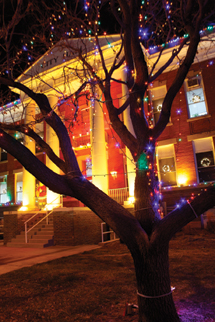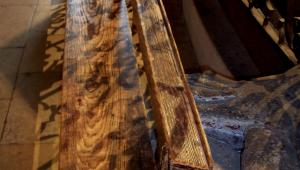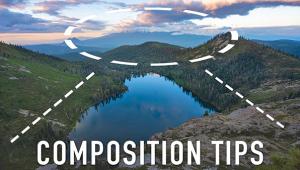Canon’s EOS-1Ds Mark III; The Big Kahuna Has Landed Page 2
 |
|
|
|
 |
Thanks to the camera's EOS Integrated Cleaning System I was able to shoot several thousand images and almost all of them were sparkling clean. When shooting raw files at f/16 and smaller, the occasional speck did show up in sky areas. The CMOS sensor has a lightweight infrared (sigh) absorption glass cover that vibrates for 3.5 seconds when the camera is turned on or off. If it bugs you, that and the little dancing logo on the LCD screen can be cancelled upon start up by pressing the shutter button halfway. Dust that has been shaken or blown loose of the sensor is trapped by adhesive surfaces à la DUST-AID (www.dust-aid.com) surrounding the sensor unit housing, preventing the particles from reattaching themselves to the filter.
 |
|
|
The shutter has a durability rating of 300,000 cycles and, though it generates less dust, it still charges itself three times during the cleaning process so that dust is shaken off shutter curtains, too. This cleaning system doesn't use much battery power and can be turned off with a Custom Function menu. The second part of the dust management system maps the location of any spots that may remain on the sensor and saves it as Dust Delete data; this is attached to the image file as a sidecar file that can be accessed with the bundled Mac OS and Windows Digital Photo Professional software. Or you can just use Photoshop's Clone Stamp tool and save lots of time bouncing back and forth between image-editing programs.
 |
|
|
Other than that big wonderful CMOS sensor, much of what is really new in the 1Ds Mark III is also part of the 1D Mark III, so instead of repeating everything I said about that camera, I'll direct you to my review in the November 2007 issue of Shutterbug or you can read it on the magazine's website, available by typing Canon 1D Mark III in the Search box on the homepage.
In The Field
The ergonomics of the 1Ds Mark III are far superior to the more fussily designed
but clearly less bulky Nikon D3 that plays Lamborghini to the Mark III's
Maserati. Neither camera is a Ferrari. I'm still waiting for the carbon
ceramic-framed model 1D Mark III I suggested Canon build last year. Image quality,
on the other hand, was sublime. You can open a raw or JPEG image--at any
ISO setting--in Photoshop and keep clicking the Magnifying Glass tool and
it never falls apart. Is it better than 35mm film? Oh yeah. Medium format film?
 |
|
|
|
 |
Maybe, depending...
While making a series of long exposures of holiday lights, I encountered an
interesting problem. While making exposures for longer than 1 second, the shutter
would fire, an exposure would start to be made but would never complete the
write operation. I could not shut the camera off and had to remove the battery
to reboot the camera. A Canon representative told me they would issue a firmware
update for this glitch that was especially a problem for certain brands of CompactFlash
cards. Sure enough, firmware update Version 1.0.6 fixes communication reliability
problems with some (or in my case all) CompactFlash cards and solves a phenomenon
involving color cast and vertical lines appearing in images--something
that I never encountered. I think we are getting to the point that with these
increasingly complex D-SLRs that it's not a bad idea to wait--as
some do with Version 1.0 software--until the first few firmware updates
are issued. Being a pioneer may mean you can be the "first kid on the
block" with a new toy but it also means that you'll be the one with
arrows in your back.
I really liked the 1Ds Mark III--what's not to like about a 21-megapixel
SLR?--but have nagging questions about reliability of any new premium D-SLR,
especially one costing $8000. Unlike our sister publication Motor Trend, no
photo magazine does really long-term tests and the AF problems reported by some
1D Mark III users, including my friend Ralph Nelson, only appeared after extended
use and not during the time I tested the camera. To keep the automotive analogies
going, Canon's response to this problem borrowed heavily from Volkswagen's
disastrous handling of defects in certain turbo-powered automobiles, but with
the issuance of a recent service bulletin they seem to be acknowledging responsibility
much as VW did after two coil packs on my GTI blew up. Based on the apology
letter Canon's Joseph Warren sent to owners of repaired 1D Mark III's,
I'm guessing this "AF Mirror Adjustment Repair" is a dead
issue, much as coil pack problems are a thing of the past for VW turbos.
The $4499 1D Mark III has the same look and feel as the 1Ds Mark III and both
cameras, for the first time in any Canon pro D-SLR's history, offer simple,
readable menus. For $8000 you can buy a 1D Mark III, two EOS 40Ds, and have
enough cash for lots of memory cards. But riddle me this: Why does a used 16-megapixel
Hasselblad digital back cost more than a brand-new 21-megapixel 1Ds Mark III?
Where's the bargain now, medium format shooters? If maximum image quality
is your main overriding question, then Canon's EOS-1Ds Mark III is the
answer.
Technical Specifications
Recording Medium: Dual slot UDMA-compliant CompactFlash Card
Type I and II, SD/SDHC Memory Card and/or external media (USB 2.0 hard drive,
via optional Canon WFT-E2A transmitter)
Image Format: 36x24mm (full-frame sensor)
Pixels: Approx. 21.10 megapixels
AF Points: 45-point (19 high-precision cross-type AF points
plus 26 Assist AF points)
Metering Modes: 63-zone TTL full aperture metering--Evaluative,
Partial, Spot, and Center-Weighted
ISO Speed Range: 100 to 1600 (in 1/3 stop or whole stop increments),
can be expanded to ISO 50 and 3200 via Custom Function
Shutter Speeds: 1/8000 sec to 30 seconds, X-sync at 1/250 sec
(with EOS dedicated external Speedlites; 1/250 sec maximum with other shoe-mount
flashes, and 1/60 sec to 1/250 sec with studio strobes)
Continuous Shooting Speed: Approx. 5 fps (at a shutter speed
of 1/(TBA) sec or faster in all Recording modes)
Max. Burst During Continuous Shooting: JPEG: approx. 56 frames;
raw: approx. 12 frames
Dimensions: 6.1x6.3x3.1"
Weight: 42.5 oz
Price: $7999
For more information, contact Canon U.S.A., Inc., One Canon Plaza, Lake Success,
NY 11042; (800) 652-2666, (516) 328-5000; www.canonusa.com.
- Log in or register to post comments

































